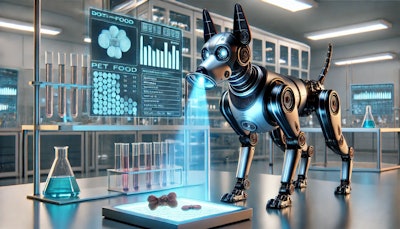
Given the hype around artificial intelligence (AI) and the fact that it seems to be everywhere, you’d be forgiven for thinking that it’s widely used and adopted, including in pet food. Is that the case?
Not according to a recent poll on PetfoodIndustry.com. And, as with so many areas of pet food, this seems to be following closely on human food’s heels in that regard.
Nearly 140 pet food professionals responded to the poll, fielded August 7-21, 2025. More than a quarter, 26%, said their companies had not yet started using AI at all, while the same percentage are uncertain about their business’s usage or have no opinion on AI. Just 36% of these pet food companies reported AI adoption.
On the human food side, 36% of companies surveyed by TraceGains in June and July 2025 reported they are not using AI at all, even higher than in pet food. Paul Bradley, senior director of product marketing at TraceGains, characterized the situation as “the majority of brands still operating in the stone ages,” as reported by Insha Naureen on FoodIngredientsFirst.com.
AI usage in human food rising but still at low level
The TraceGains survey results represented the use (or non-use) of technology in general among 190 food and beverage companies, both small and large, including digital tools to aid new product development (NPD). “Despite 83% of brands planning to boost NPD this year, only 2% say their product development processes are fully digitized,” Naureen wrote.
In terms of AI specifically, 17% of the companies surveyed reported being “all in” on using it, up from 10% in a similar survey conducted in 2024, so usage is rising. At the same time, skepticism about AI is declining, “with only 32% remaining unconvinced, compared to 44% last year,” according to the TraceGains report quoted by Naureen. Yet, almost 56% of companies remain “somewhat reliant” on manual tools, with only 16% using digitized systems.
For food companies that have adopted AI at any level, the most common areas of usage are gleaning market insights at 24.7%, streamlining compliance at 9.5% and accelerating formulation at 9%.
Pet food companies using AI for marketing and sales, too
Similar to those human food companies, the 36% of pet food companies using AI in pet food employ it mostly for marketing and sales applications such as identifying customer targeting and campaign optimization (used by 35% of respondents), followed by market insights — think consumer trends and competitive analysis — at 21%. These results were reported by my colleague, Lisa Cleaver.
Other AI uses in pet food, at least among these respondents, include production efficiency improvements focused on manufacturing optimization and quality control (18%), as well as product formulation applications like recipe optimization and ingredient alternatives, and regulatory compliance processes (13% each).
“The emphasis on marketing and sales suggests that pet food companies view AI primarily as a tool for better understanding and reaching consumers rather than for optimizing internal operations or product development processes,” Cleaver wrote. Which not only mirrors what’s happening in human food regarding AI adoption but also seems somewhat surprising.
The lack of usage or awareness of opportunity for AI to improve operations or product development may be due to a lack of skills or expertise about the technology. Nearly 25% of respondents to the survey identified this as the primary challenge to adoption, significantly outpacing other barriers.
“The other large category of barriers fell under ‘other’ responses (27%), indicating that many companies face challenges not captured in the standard survey options,” Cleaver reported. “Among the specified barriers, outdated systems and legacy workflows present obstacles for 15% of respondents, while 17% see no perceived need for AI, believing their current processes work adequately without technological enhancement.” (All of which calls to mind some of the attitudes expressed by the human food companies in the TraceGains survey.)
“Data quality issues affect nearly 10% of companies, preventing them from moving forward with AI applications,” Cleaver continued, “while cost concerns and unclear return on investment represent barriers for just 7% of respondents — suggesting that financial considerations may be less significant than anticipated.”
Not jumping on the bandwagon just yet
Financial constraints don’t seem to play a major role in lagging AI adoption in human food, either. In some of those cases, macro-economic and global trade issues may factor in. “Companies are financing technology upgrades, and 40% are more likely to invest in them due to global trade volatility,” Naureen wrote on FoodIngredientsFirst.com. “Some 18% prioritize upgrades or maintenance of existing systems, while 13% will focus on compliance tech to deal with regulatory uncertainty.”
Bottom line: AI may offer promise, but as with any new and disruptive technology or phenomenon, the business world (at least in the form of consumer goods consumables companies) is taking its time to evaluate and perhaps see how adoption of the technology plays out for others. Despite some consumer interest in AI in businesses — Naureen cited Innova Market Insights data indicating almost 41% of consumers surveyed globally see its potential in developing food and beverage products — unless there is significant, undeniable consumer demand or a clear, strategic business imperative, companies aren’t jumping on the AI bandwagon just yet.


















